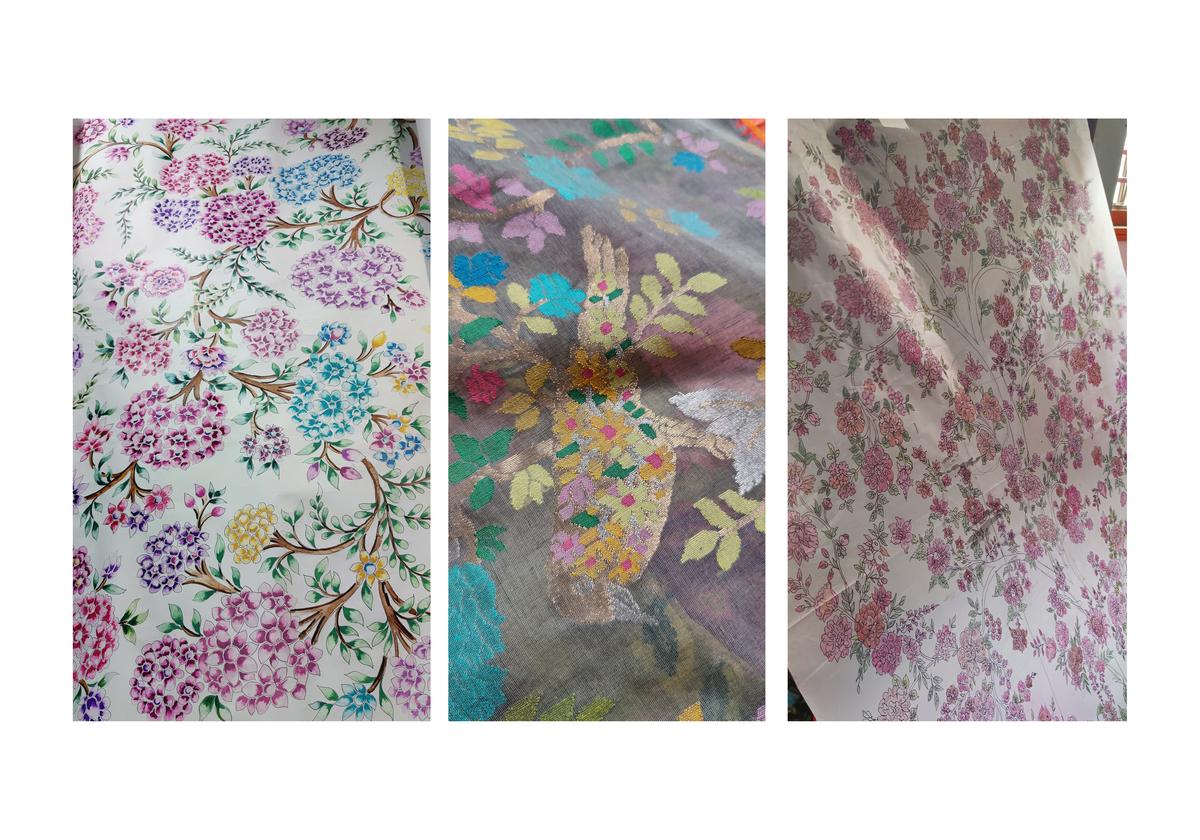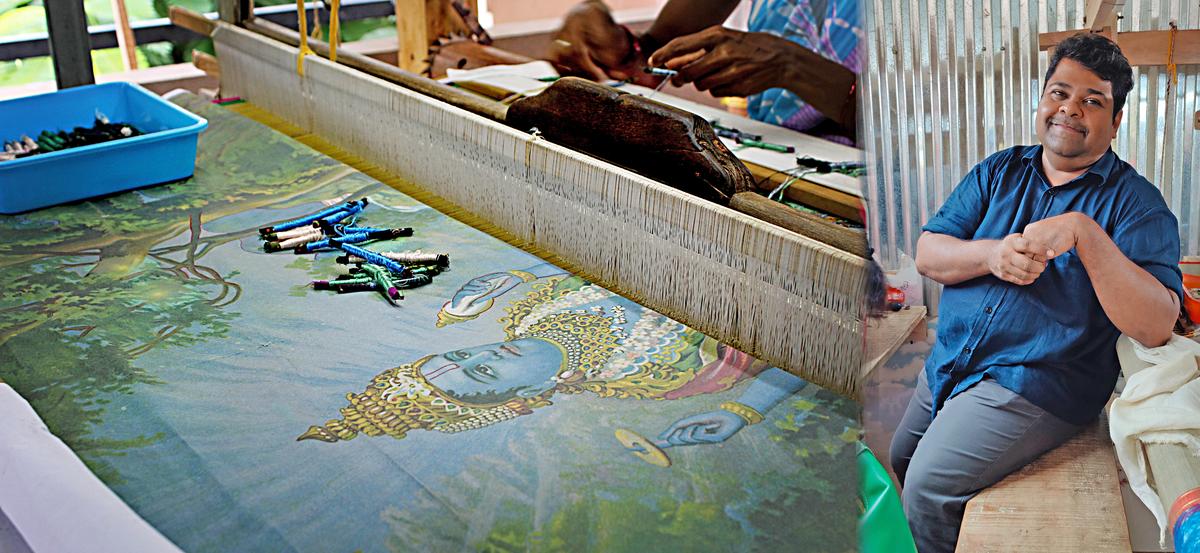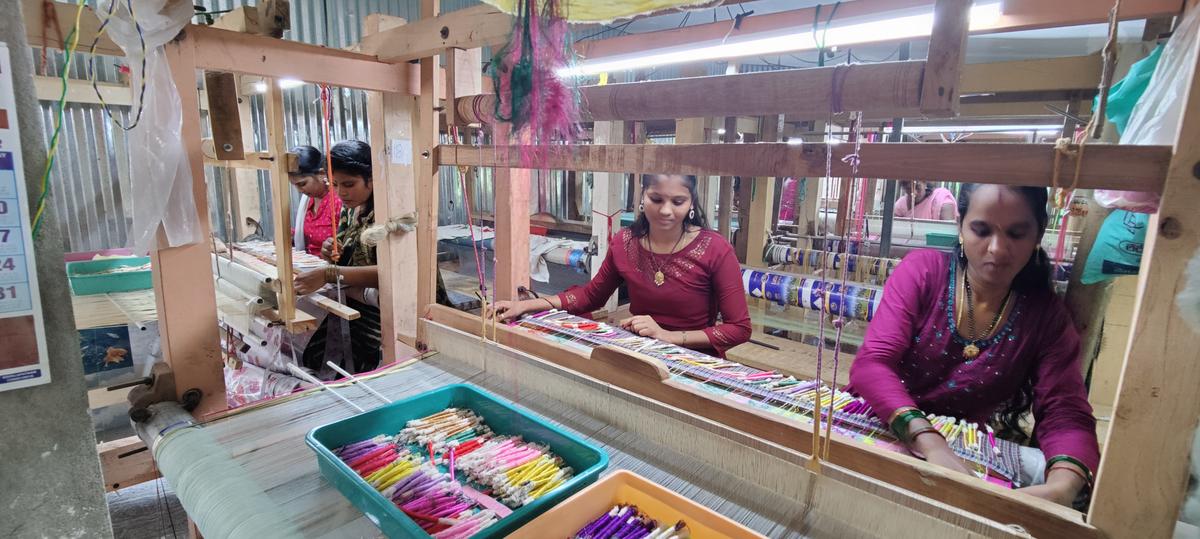[ad_1]

The jamdani process in the looms in Srikakulam is intricate and meticulous
| Photo Credit: Sangeetha Devi Dundoo
Jyothi and Suma rarely take their eyes off the loom, even to talk; they patiently count the threads and go about the weaving process. They are among the 50 women who work at a 25-loom facility, with two women working on each loom, at Alikam village in Srikakulam district, Andhra Pradesh. The women have been trained to weave the famed jamdani of Srikakulam. “All of us work here from 9am to 6pm,” says Jyothi. The saris these women weave are commissioned by Hyderabad-based textile designer Gaurang Shah, who intends to expand this unit to 100 looms. So far, he has helped establish 120 looms in Srikakulam and facilitated the training of more than 300 women weavers.
Gaurang remembers the village barely having decent roads in the early 2000s. Annaji Rao, who supervises the facility, nods in agreement. It began as an initiative with a few looms and gradually expanded as more women expressed interest in learning the process and earning a steady income. While the men were primarily engaged in agriculture, the women were vegetable vendors or helped in the fields. The looms provided an alternative employment opportunity; the women weavers earn between ₹14,000 and ₹20,000 per month.

Hand-painted or hand-drawn design sheets and the final sari, designed by Gaurang Shah
| Photo Credit:
Special Arrangement
A few women who have since become expert jamdani weavers have relocated to nearby villages after marriage and work from their homes, with looms being set up for them. “In some villages, there are two women, in some, there are five to 10. Work gets scattered but it has to continue. So we set up looms according to their convenience,” says Gaurang. Unlike traditional pit looms, these are table looms that allow easy portability.

What is special about these women weavers and their craft? The jamdani saris woven here on khadi, cotton or organza, are not mass-produced. These can be considered wearable art, catering to a premium segment. A few saris are priced ₹3 lakh upwards. “Our jamdani designs require patience and the women might be able to weave only half or an inch per day,” explains Gaurang.
What is jamdani?
The book Interlace: Discover the Soul of Jamdani, commissioned by Gaurang Shah to complement his earlier collection of woven saris that showcased jamdani techniques from different regions of India, gives a brief history of the craft. Jamdani is a discontinuous weft technique of weaving. Motifs are inlaid into the fabric by adding a denser thread to fine-warp threads, by hand. Said to be one of the most advanced and time-consuming weaving techniques, jamdani originated in Dhaka and used the finest muslin. Today, skilled weavers keep the tradition alive in Andhra Pradesh, Rajasthan, Maharashtra and Uttar Pradesh, among other states. In Srikakulam, the looms hold the warp and weft threads together, and a third thread is added discontinuously to create desired patterns.
They have also woven museum-worthy collections that are not for sale. Textile connoisseurs might recall Gaurang’s project that recreating Ravi Varma’s paintings with the help of jamdani weavers on khadi, employing natural dyes. The collection of more than 30 saris that took shape in this region, which has since been showcased in national and international museums, is nothing less than a weaving marvel.

One of the saris on the loom as part of ‘Khadi, a canvas’ project; Gaurang Shah
| Photo Credit:
Sangeetha Devi Dundoo
Cut to the present and women weavers work diligently to execute the intricate designs given to them. It can take a year or more for a sari to be woven. Jamdani weaving is done on organza or khadi of varying counts, from 80 to 150 or more, getting finer as the thread count increases.
Designs for the whole six metres are hand drawn or hand painted on gateway sheets of paper custom-made to the length and breadth of saris, Gaurang explains, showing a tree of life design. Srikakulam jamdani technique allows the designer and the weavers to create patterns without repetition as the weaver places the whole six-metre design sheet (which takes more than a month to draw) under the warp and execute the design.
Khadi as a canvas
Khadi: A canvas is a project presented by Abheraj Baldota Foundation with Gaurang Shah as a tribute to Mahatma Gandhi and Raja Ravi Varma. Gaurang’s team of weavers recreated Varma’s paintings on the looms using jamdani on khadi. The collection was unveiled as part of a multidisciplinary exhibition titled Santati at the National Gallery of Modern Art, Mumbai, to commemorate the 150th birth anniversary of Mahatma Gandhi. The collection was also showcased in Hyderabad, New Delhi, Ahmedabad, Baroda and New York.
Known to experiment with the weaves, Gaurang shows a sari in the making that uses 11 shuttles (11 wefts) on a loom. He then shows a finished sari woven using the Paithani jamdani technique in which brightly coloured flowers and birds constitute the design palette, with the birds containing several flowers within them — all woven minutely to resemble a painting. The women weavers, he says, patiently count the threads — 80 or more an inch, as required for the design.

Some of the women at the jamdani unit established by Gaurang Shah
| Photo Credit:
Sangeetha Devi Dundoo
Gaurang, who liaises with weavers and craftspeople across the country, reckons that the possibilities are endless. At times, it is about reviving forgotten heritage motifs. A sari with a Paithani design of four peacocks within a circle is an example. A few rare designs, featured on textiles preserved at the Calico Museum of Textiles in Ahmedabad, are also being revived. The jamdani facility we are visiting is one of the two set up by Gaurang, apart from individual looms in a few homes. “There is scope to train and engage more weavers. More than 90% of the weavers in these facilities are women. Since it provides them with a steady income, quite often we get requests. People tend to paint a dismal picture of weaving communities and handlooms. But there is ample scope for good work.” Gaurang would know, given his nearly three-decade journey in handlooms. He takes pride in calling himself a textile, not a fashion designer, and is glad to cater to a niche section that looks for heirloom worthy handloom saris.
(The writer visited these looms on invitation)
[ad_2]
Source link





